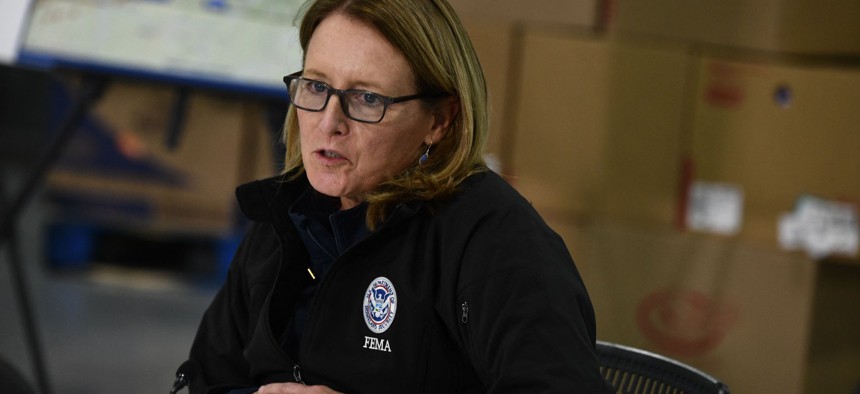FEMA Experiences ‘Mass Exit’ of Employees Amid Surge in Disasters
The agency is still dealing with 1,000 disasters as its workload continues to climb.
The growing barrage of natural disasters and other responsibilities for the Federal Emergency Management Agency has resulted in high turnover and insufficient workforce development, officials told a congressional panel on Thursday, even as the agency has added thousands of workers in recent years.
FEMA has grown its overall workforce by around 5,000 employees over the last five years, a nearly 30% jump. That includes many temporary and non-career staff, who are generally activated only to respond to emergencies. Its permanent, full-time workforce, however, has remained steady over that time. As disasters become more severe and frequent, the workforce is increasingly strained and struggling to keep pace with its workload, former and oversight officials told a joint hearing within the House Homeland Security Committee. While FEMA has added more non-career staffers to its rolls, those employees are improperly trained and less likely to meet the growing demand for deployments, witnesses at the hearing said.
In the 1960s, the United States declared an average of 18 major disasters per year. The emergency response agency responded to 104 such disasters in 2020 and 58 last year. Its capacity to quickly deploy around the country and handle logistics has also led it to take on various other projects in recent administrations, such as helping with a surge of migrants crossing the U.S.-Mexico border, the resettling of Afghan evacuees and the COVID-19 pandemic response. This has led to more turnover—and less experience—throughout the agency, lawmakers and witnesses said.
“In 2020, more FEMA workers transferred to other agencies than in any other year over the past decade,” said Rep. Val Demings, D-Fla., who chairs the Emergency Preparedness, Response and Recovery Subcommittee. “This mass exit may be attributed to the workload. Past employees have described working 12-hour days and not having enough time to recover between assignments.”
FEMA employees previously sounded the alarm on their lack of down time between deployments and the agency last year sought to bring employees home from pandemic-related assignments to allow them to rest before hurricane season. The recovery period was short lived, however, as President Biden was quickly forced to once again send out FEMA workers to help states deal with new waves of COVID-19 cases.
The confluence of activities is “exhausting the workforce,” said Rep. Kat Cammack, R-Fla. “Employee fatigue poses extraordinary challenges,” she said.
Craig Fugate, who led FEMA during the Obama administration, said FEMA reservists are not treated like their military counterparts. The FEMA reservists do not receive benefits or incentives except when they are actively deployed, and are paid out of funds from specific disaster accounts, so they are never properly trained. With the job market currently favoring workers, it is difficult for FEMA to attract well-qualified candidates to deploy at a moment’s notice.
“They are not incentivized when they’re not deployed. They really don’t get any benefits outside of when they’re deployed,” Fugate said. “That model doesn’t scale up with the frequency of disasters, nor does it work very well when the economy is strong because of the shortfall of employees.” The agency and Congress must address how to create better perks and protections for those employees, he added.
Chris Currie, director of the Government Accountability Office's Homeland Security and Justice team, noted that each disaster FEMA responds to only adds to its backlog of work, as the agency is currently still actively managing more than 1,000 incidents.
“There’s never been more pressure on the FEMA workforce and they’re tired,” Currie said. “The workforce structure has not been transformed and evolved to fit what we’re asking them to do right now.”
In addition to workforce reforms, Currie and Fugate encouraged lawmakers to alter the agency’s processes so it can disburse funds and close out its work on disasters faster. Career FEMA employees currently spend much of their time at a desk handling case work, but those efforts are inevitably disrupted when the next disaster strikes.
Without addressing its process and workforce challenges, FEMA "puts in jeopardy its ability to effectively carry out its mission," said Rep. Lou Correa, D-Calif.
“The workforce is suffering from an increase in burnout and in recent years significantly more employees have left the agency than usual,” Correa said. “It is absolutely critical that FEMA address these rising attrition rates, and prioritize the needs of its people.”








